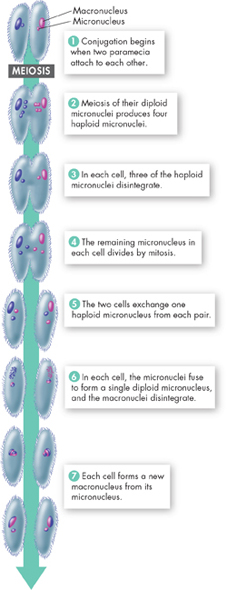Protist Reproduction
 How do protists reproduce?
How do protists reproduce?
The incredible variety of protists is reflected in their varied life cycles.  Some protists reproduce asexually by mitosis. Others have life cycles that combine asexual and sexual forms of reproduction.
Some protists reproduce asexually by mitosis. Others have life cycles that combine asexual and sexual forms of reproduction.
Cell Division Amoebas reproduce by mitosis: They duplicate their genetic material and then simply divide into two genetically identical cells. Most other protists have phases in their life cycle in which they also produce new individuals by mitosis. Mitosis enables protists to reproduce rapidly, especially under ideal conditions, but it produces cells that are genetically identical to the parent cell, and thus limits the development of genetic diversity.
Conjugation Paramecia and most ciliates reproduce asexually by mitotic cell division. However, under stress, paramecia can remake themselves through conjugation—a process in which two organisms exchange genetic material, as shown in Figure 21–6. After conjugating, the cells then reproduce by mitosis.
Paramecium has two types of nuclei: a macronucleus and one or more smaller micronuclei. The micronucleus is a bit like a reference library where books don't circulate—it holds a “reserve copy” of every gene in the cell. The macronucleus is more like a lending library—it has multiple copies of the genes the cell uses in its day-to-day activities.

FIGURE 21–6 Conjugation During conjugation, two paramecia attach to each other and exchange genetic information. Interpret Diagrams What do paramecia exchange during conjugation?
ddConjugation is not a type of reproduction because no new individuals are formed. It is, however, a sexual process, using meiosis to produce new combinations of genetic information. In a large population, conjugation helps produce and maintain genetic diversity, the raw material for evolution.
Sexual Reproduction Many protists have complex sexual life cycles in which they alternate between a diploid and a haploid phase, a process known as alternation of generations. An example is the life cycle of a type of protist known as a water mold. Water molds, or oomycetes (oh oh MY seets), thrive on dead and decaying organic matter in water or as parasites of plants on land.
Table of Contents
- Formulas and Equations
- Applying Formulas and Equations
- Mean, Median, and Mode
- Estimation
- Using Measurements in Calculations
- Effects of Measurement Errors
- Accuracy
- Precision
- Comparing Accuracy and Precision
- Significant Figures
- Calculating With Significant Figures
- Scientific Notation
- Calculating With Scientific Notation
- Dimensional Analysis
- Applying Dimensional Analysis




